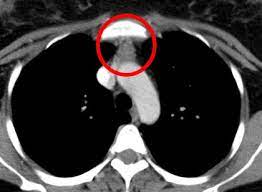Mediastinal Mass Management
The differential diagnosis of an anterior mediastinal mass includes many entities and in a young adult, may prompt surgery for diagnosis and/or treatment. Except for lymphomatous involvement of the mediastinum, many would consider median sternotomy and resection appropriate for both diagnosis and therapy. Benign thymic hyperplasia has been found in association with hyperthyroidism in a few cases over the past 60 years. It is by no means common, however, and is not emphasized in major endocrinology texts. Yet pathologically, approximately one-third of patients with thyrotoxicosis will have microscopic abnormalities of the thymus gland with the presence of medullary lymphoid follicles upon biopsy. Recognition of the association of BTH and HTH and regression of the thymus following treatment of the hyperthyroid state may preclude the need for an invasive diagnostic or therapeutic procedure.
Our series serves to illustrate the evolution of our approach to such patients. The first patient underwent a thymectomy to exclude thymoma or other malignancy. In patient 2, recognition of the association of thymic hyperplasia with HTH, as further confirmed by biopsy, spared the patient further surgery. In both patients 2 and 3, successful treatment of HTH resulted in involution of the enlarged thymus gland. It is very important to be attentive to your health and together with Canadian Neighbor Pharmacy you may become safe and sound.
Thymic Enlargement Mechanism
The mechanism of thymic enlargement in hyperthyroidism is not well established. B-cell lymphocytes produce an IgG immunoglobulin responsible for the hyperplasia and hyperactivity of the thyroid gland in Graves’ disease. There is some evidence that T-cell lymphocytes also have a supportive role in this disorder. However, the removal of the thymus gland in a patient with both thymic hyperplasia and Graves disease did not ameliorate the patient’s HTH. The thymus of that patient neither contained nor synthesized the LATS immunoglobulin. Alternatively, thymic hyperplasia may be caused by excess thyroid activity. Thyroidectomy has been associated with thymic involution, and administration of triiodothyronine can induce thymic hyperplasia. Treatment with antithyroid drugs, including propranolol, may cause a decrease in thymic enlargement in men, either by direct effect on the thymus or by control of hyperthyroidism.
Thymic Enlargement Resolution with Euthyroid State
In summary, BTH may be a direct consequence of hyperthyroidism, and a return to a euthyroid state is associated with the resolution of thymic enlargement. Therefore, we believe that median sternotomy and resection are inappropriate in patients with an anterior mediastinal mass and hyperthyroidism. Treatment with appropriate antithyroid therapy should result in regression of the thymus. Invasive diagnostic procedures such as mediastinoscopy can be used when regression does not occur or when there is a clinical suspicion of another process in the mediastinum.



